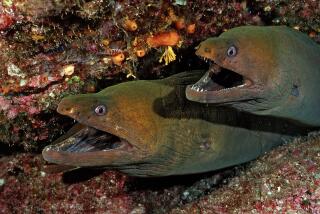Japanese tsunami debris proves dangerous: Invasive species found
- Share via
SEATTLE -- The 65-foot-long floating dock that washed up in central Oregon last week from last year’s tsunami in Japan was surprising enough. What proved stunning to scientists who rushed down to examine it was the cargo: About 2 tons of living sea creatures, some of which could devastate local sea life populations.
“There was a huge amount of stuff. They were very healthy, very reproductive. And included in the list of species that we could identify were some very, very bad characters that we really are afraid of having here — so yes, this really is a horrible thing,” said John Chapman of Oregon State University’s Hatfield Marine Science Center.
The large concrete and Styrofoam pier, washed off the coast of northern Japan during the March 2011 earthquake and subsequent tsunami, contained at least 30 species — and possibly more. Many were not native to the U.S. coast, said Chapman, an expert in aquatic biological invasions.
The discovery on a quiet beach outside of Newport, Ore., shocked scientists, he said, because never before have they seen a piece of ocean debris wash up with traveling wildlife from so far away.
Usually, debris washes ashore with the kind of barnacles and other sea life common to the deep sea, posing no threat to shoreline populations.
“When we walked up to that float on the shore and saw it covered with Japanese organisms, it was the first minute that anybody has really worried about introduced organisms with marine debris. It was like landing on the moon,” Chapman said in an interview.
“It took us some time to just sort of grasp the enormity of what this was. We didn’t think such a thing could happen. And there it was, on our beach.”
Shoreline communities along the West Coast, such as Los Angeles Harbor and San Francisco Bay, are always battling the problem of invasive species to one degree or another. Sometimes they’re brought in on bilge water from cargo ships, though tightened restrictions in California are making headway on that problem.
Australian officials have been battling the introduction of the Northern Pacific star fish, or Asterias amurensis, in Tasmania for years. “If the Australians could push a button and kill them all, they would do it. They’d push on top of each other to do it,” Chapman said.
Guess what scientists found on the Japanese dock?
Not only the Northern Pacific star fish, but Japanese shore crabs and brown algae -- Undaria pinnitifida -- the kind used for making Japanese miso soup. (California officials already are trying to get rid of the algae near Monterey Bay.)
“We saw those three things right away, and we thought, ‘Oh, if none of these other characters on there mattered, we knew this was a totally bad crew. And we don’t want them,’” Chapman said.
Scientists immediately called the Oregon Department of Fish and Wildlife and the Department of Parks and Recreation, which oversees the beaches, and told them they had an emergency on their hands.
“We had to say, ‘Please kill this as fast as you can,’” Chapman said.
Within two days, workers were out on the dock, scraping as many of the animals away as possible and burying them eight feet under the sand on the beach. They then attacked the dock with blowtorches to try to kill what was left.
The state is now accepting bids to remove the dock, which has attracted thousands of sightseers since its arrival June 5.
They can’t go fast enough for Chapman.
“When this thing first showed up, people were trying to figure out where it came from, and it had a plaque with Japanese characters, so they could tell exactly where it came from. But the biologists that were there didn’t need that,” he said. “It was writ large on the float: This is from Japan.”
ALSO:Taco Bell hoax: Alaska town (pop. 6,000) left reeling
Perhaps we need some help with PR, say Catholic bishops
Lance Armstrong barred from Hawaii Ironman; fans crushed
Follow Kim on Twitter @kimmurphy. Email: [email protected]
More to Read
Sign up for Essential California
The most important California stories and recommendations in your inbox every morning.
You may occasionally receive promotional content from the Los Angeles Times.










